Evil statistician tells schoolchildren the truth about inequality in America
 Hispanic, female, Ph.D. statistician who loves math. Hoo-wee, we hit the lottery! Let’s have her come talk to our inner city school children about STEM education. It’ll be SO uplifting.
Hispanic, female, Ph.D. statistician who loves math. Hoo-wee, we hit the lottery! Let’s have her come talk to our inner city school children about STEM education. It’ll be SO uplifting.
Ri-i-ight.
(Oh, by the way, one million brownie points to the teacher who knew me but invited me anyway.)
Given that the students are 12 – 14 years old, I did not want to make the analyses too complicated but I wanted to hit some basic points.
First, that statistics can tell you the truth about the world, truths these kids already know because of the environment in which they live, but which are often glossed over in the news.
Second, you need to look past the simple answers. Statistics involves asking questions about your data. For example, if you look at what percentage of people in California have jobs it’s about 56%, but that includes newborn babies and people over 100 years old. To get better answers, you should look at the people of “working age”. Who gets to say what ‘working age’ is? If you say that it is over 20, because people are in college, that gives you a different answer than if you say it is over 17 because most people have either dropped out or graduated from high school and are looking for a job by 18.
Third, America is not nearly as equal as we like to pretend. Income is radically skewed and almost everything – income, education, employment – varies by race and gender.
Everybody is not equal – not even close
To understand income in America, you need to know the difference between the mean and the median, a difference that turns out to be very, very important in understanding income. The mean is the average, to get it, you add up the total of something, say, how much money each person makes, and divide by the number of things (or, in this case, people) that you collected data on. So, if we have nineteen unemployed people, all making zero dollars, and someone who is making $20 million then the mean is the total of how much everybody altogether was making divided by the number of people, or $20 million divided by twenty. The mean is $1 million. Now try telling those 19 unemployed people that everything is great because the average person in the room is making a million dollars a year. How many of them would slap you at that point is a statistic I don’t have, but it would be interesting to know.
The MEDIAN is the middle of a distribution, that’s the point that half of the people are higher and half are lower. For our group of 20 people, the median income is zero dollars. When a distribution is very skewed – that is bunched up on one end and then going out very, very far to the other end, using the median gives you a lot better picture of what it’s like for most people than the mean.
Let’s look at the distribution of income:
Of the working age population, which is people from age 18 to 62 by my definition, 51% in California make $20,000 a year or less. According to a couple of sources I found, the highest paid 400 people in the country earned over $300,000,000 a year . About 10% of the wealthiest people in the country live in California, so I am assuming about 10% of the highest earners do as well. Certainly, some of them do.
So, the highest paid 40 (or so) people in the state each make in one year what the bottom half of the people would make if they worked for FIFTEEN THOUSAND YEARS!
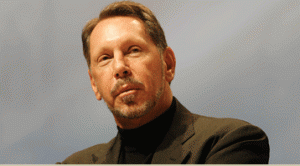 The wealthiest person in California is Larry Ellison, CEO of Oracle and reported to be worth $22.5 billion. Now, this is the amount of money he HAS, not how much he earns in year. For that bottom half of the people, they would need to work 1,125,000 years to make that much money. Are you getting the idea yet that just working overtime isn’t going to get you there? Of course, the way you get $22 billion isn’t by working for over a million years. You get some money and then you invest it in factories, buildings, hire some workers, invest in bonds, stuff like that. Have you heard that saying that the rich get richer and the poor get poorer? Well, the fact is, they do.
The wealthiest person in California is Larry Ellison, CEO of Oracle and reported to be worth $22.5 billion. Now, this is the amount of money he HAS, not how much he earns in year. For that bottom half of the people, they would need to work 1,125,000 years to make that much money. Are you getting the idea yet that just working overtime isn’t going to get you there? Of course, the way you get $22 billion isn’t by working for over a million years. You get some money and then you invest it in factories, buildings, hire some workers, invest in bonds, stuff like that. Have you heard that saying that the rich get richer and the poor get poorer? Well, the fact is, they do.
Median income is the part that half the people make more and half make less. For California, median income for people from 18-62 years old is $20,000. Remember our nineteen unemployed people and the one guy with $20 million a year? This is starting to sound like that, isn’t it?
Here are two interesting facts I found on the Internet,
- The census bureau says Generally, the long-term trend has been toward increasing income inequality, and
- According to Professor Domhoff , most people in America are very far off in thinking how equal America is.
 I was talking to my friend today – that’s him on the left. Like Larry Ellison, he’s president of a company he started. He isn’t worth $22 billion, though. He teaches about ethics (think of it like church without mentioning God), and he said he was confused that even though he saw lots of people who didn’t have the values he teaches about like honesty, courage and generosity, that still America is the number one country in the world so maybe those values aren’t so important. He asked how I explained that. I asked him what he meant by America is the greatest country in the world and he was surprised.
I was talking to my friend today – that’s him on the left. Like Larry Ellison, he’s president of a company he started. He isn’t worth $22 billion, though. He teaches about ethics (think of it like church without mentioning God), and he said he was confused that even though he saw lots of people who didn’t have the values he teaches about like honesty, courage and generosity, that still America is the number one country in the world so maybe those values aren’t so important. He asked how I explained that. I asked him what he meant by America is the greatest country in the world and he was surprised.
“You know, we have the most freedom, equality, democracy.”
In fact, when it comes to income equality, we are not even close to number one. We’re number 93.
So … why is it so unequal?
Race is related to income – by a lot
The graph above shows average personal income by race for California. Yes, the rate for whites is more than double that for Hispanics. Maybe, though, this is due to a few really, really rich people. After all, Larry Ellison is white. Maybe it’s all his fault.
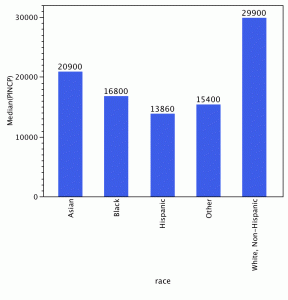 No, that’s not it. We do see a couple of really interesting things here. First, for EVERY race, the median is a lot less than the mean. When you see a big difference between the mean and median like that, it usually means the distribution is skewed, that is, there are a lot of people bunched at one end. Okay, we already knew that. This tells us though, that the distribution is skewed for every race. It also says that the difference between races is NOT due to just a few really rich people. Larry is off the hook.
No, that’s not it. We do see a couple of really interesting things here. First, for EVERY race, the median is a lot less than the mean. When you see a big difference between the mean and median like that, it usually means the distribution is skewed, that is, there are a lot of people bunched at one end. Okay, we already knew that. This tells us though, that the distribution is skewed for every race. It also says that the difference between races is NOT due to just a few really rich people. Larry is off the hook.
Perhaps the difference is due to age. People tend to make more money as they get older, and then less as they retire. (This is called a curvilinear relationship). The graph below shows the relationship between age and income by race.
The Difference in Income Between Races is not Due to Age
You can see that for all races income goes up from about 16-30. For Asians and non-Hispanic whites it goes up at a steeper rate and for a longer period. So, no, the difference is not due to Hispanics being younger (although it happens that they are). Hispanics, and, to a lesser extent, blacks, make less money at all ages.
So … it isn’t age, it isn’t due to just a few really rich people. Why is there such a difference between races? Is it all explained by education? How did Hispanic get to be a race? Doesn’t the census say that Hispanics can be of any race? And who are those “other” people anyway?
All good questions, but they will have to wait until the next blog because it is close to midnight and I can hear very loud music upstairs from the bedroom where my own little seventh-grader is very obviously not asleep. I must now transform from evil statistician to evil mother.
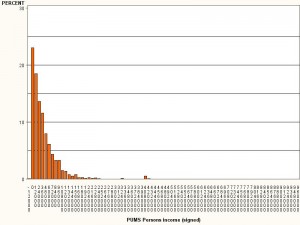
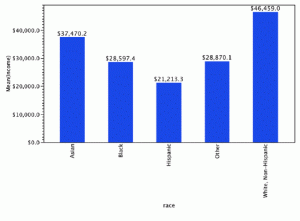
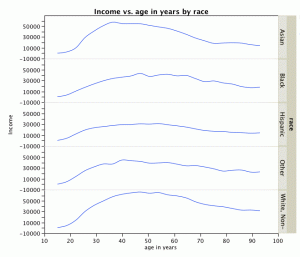
How did the students and teacheres react to your presentation? Have you read The Spirit Level? I recently listened to a podcast from the author. He argues that relative poverty is a clearer indication of societal health than absolute poverty and includes study after study that show higher levels of societal ills (drug use, suicide, teen pregnancy, etc) in areas where the gaps are larger between the rich and the poor.
I haven’t given the presentation yet. It’s this week. I’ll let you know how it goes.
I agree about relative poverty. If everyone around you is poor, you don’t think of that as poor, just normal.
What I see as particularly insidious in America is our denial that we DO have enormous inequality and the insistence that if these kids just tried harder they would do equally well as the world’s most spoiled seventh grader who lives in my house. The fact is, they would have to try MUCH harder just to be equal with her because she has so many advantages from technology, to a safe place after school, to two parents with graduate degrees to help her with homework every night.
Would you be able to recreate these graphs for those who graduated college and those who didn’t? It would be interesting to see if there is a lesser or greater equality gap between specifically college graduates or specifically those who did not graduate.
A note on Larry Ellison: he was not born rich. He made his riches through hard work plus innovation, which requires mental effort. Whether people know it or not, his database design has improved the lives of millions of people. Sadly, I do not believe that our current system of education is not challenging enough to get students to exert enough mental effort needed to advance their careers past “having a job”.
As for US poverty relative to the rest of the world, here is some more information from the US Census Bureau:
Forty-three percent of all poor households own their own homes. The average home owned by persons classified as poor by the Census Bureau is a three-bedroom house with one-and-a-half baths, a garage, and a porch or patio.
Eighty percent of poor households have air conditioning. By contrast, in 1970, only 36 percent of the entire U.S. population enjoyed air conditioning.
6 percent of poor households are overcrowded. More than two-thirds have more than two rooms per person.
The average poor American has more living space than the average individual living in Paris, London, Vienna, Athens, and other cities throughout Europe. (These comparisons are to the average citizens in foreign countries, not to those classified as poor.)
Nearly three-quarters of poor households own a car; 31 percent own two or more cars.
Ninety-seven percent of poor households have a color television; over half own two or more color televisions.
Seventy-eight percent have a VCR or DVD player; 62 percent have cable or satellite TV reception.
Eighty-nine percent own microwave ovens, more than half have a stereo, and more than a third have an automatic dishwasher.
Contrast this also to the earlier half of the 20th century where poverty meant you had difficulty acquiring toilet paper.
I agree very much with your statement that access to technology has big impact on quality of life, which is why we engineers strive to design better technology, which costs less, increasing the quality of life for everybody. This is why America is the greatest country in the world.
Edit to my post above, as I failed to proof read it before posting (like I said, I’m an engineer):
“I do not believe that our current system of education is not challenging enough to get students to exert enough mental effort…” should be “I do not believe that our current system of education is challenging enough to get students to exert enough mental…”
Just to put things into perspective, here are some interesting results from a recent study commissioned by Wider Opportunities for Women and reported in the NY Times.
According to the report, a single worker needs an income of $30,012 a year — or just above $14 an hour — to cover basic expenses and save for retirement and emergencies. That is close to three times the 2010 national poverty level of $10,830 for a single person, and nearly twice the federal minimum wage of $7.25 an hour.
A single worker with two young children needs an annual income of $57,756, or just over $27 an hour, to attain economic stability, and a family with two working parents and two young children needs to earn $67,920 a year, or about $16 an hour per worker.
That compares with the national poverty level of $22,050 for a family of four. The most recent data from the Census Bureau found that 14.3 percent of Americans were living below the poverty line in 2009.
The report compares its standards against national median incomes derived from the census, and finds that both single parents and workers who have only a high school diploma or only some college earn median wages that fall well below the amount needed to ensure economic security.
Dominic –
The median home price for the area where these students live is $300,000. I think it is pretty safe to say that almost none of them live in a 3-bedroom home their parents own.